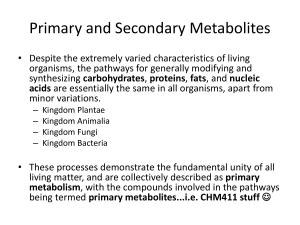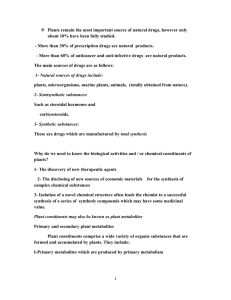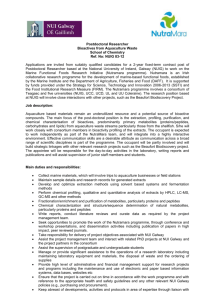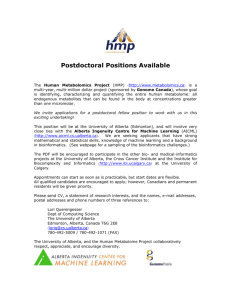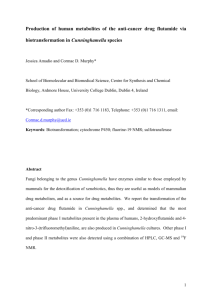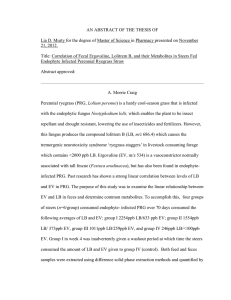Secondary Metabolism Products in Mediterranean Plants
advertisement
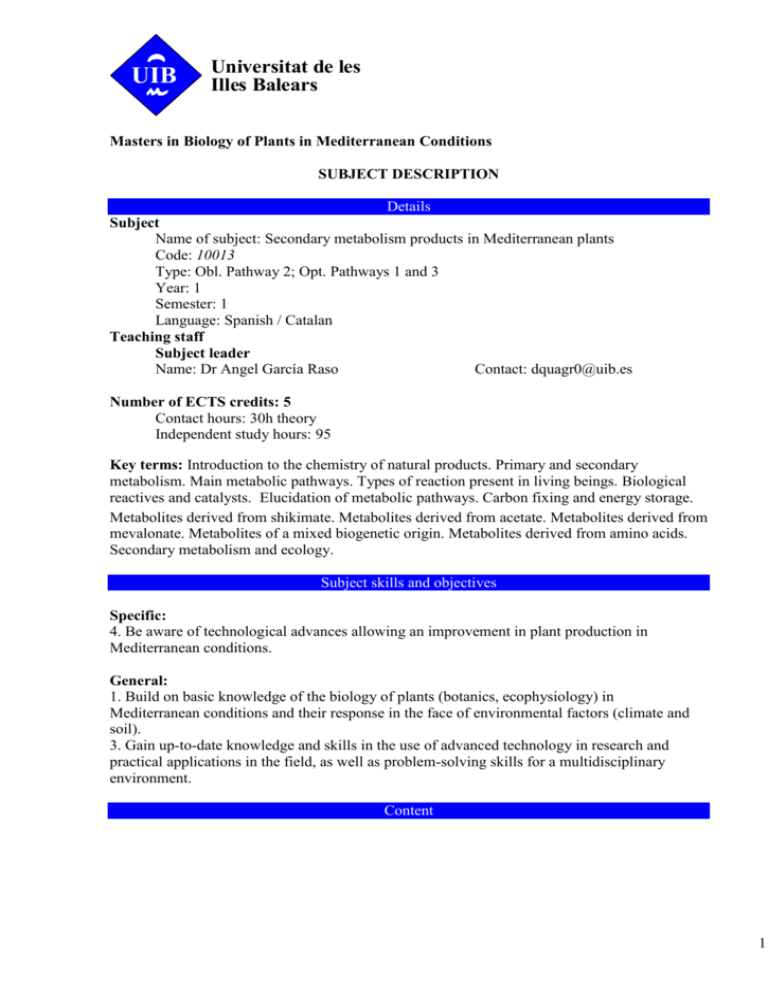
UIB Universitat de les Illes Balears Masters in Biology of Plants in Mediterranean Conditions SUBJECT DESCRIPTION Details Subject Name of subject: Secondary metabolism products in Mediterranean plants Code: 10013 Type: Obl. Pathway 2; Opt. Pathways 1 and 3 Year: 1 Semester: 1 Language: Spanish / Catalan Teaching staff Subject leader Name: Dr Angel García Raso Contact: dquagr0@uib.es Number of ECTS credits: 5 Contact hours: 30h theory Independent study hours: 95 Key terms: Introduction to the chemistry of natural products. Primary and secondary metabolism. Main metabolic pathways. Types of reaction present in living beings. Biological reactives and catalysts. Elucidation of metabolic pathways. Carbon fixing and energy storage. Metabolites derived from shikimate. Metabolites derived from acetate. Metabolites derived from mevalonate. Metabolites of a mixed biogenetic origin. Metabolites derived from amino acids. Secondary metabolism and ecology. Subject skills and objectives Specific: 4. Be aware of technological advances allowing an improvement in plant production in Mediterranean conditions. General: 1. Build on basic knowledge of the biology of plants (botanics, ecophysiology) in Mediterranean conditions and their response in the face of environmental factors (climate and soil). 3. Gain up-to-date knowledge and skills in the use of advanced technology in research and practical applications in the field, as well as problem-solving skills for a multidisciplinary environment. Content 1 1. 2. 3. 4. 5. 6. 7. 8. 9. Introduction to the chemistry of natural products. Antecedents. Primary and secondary metabolism. What is a secondary metabolite? Relationships between primary and secondary metaboites. Main metabolic pathways. Types of reaction present in living beings. a) Formation of C-C bonds. b) Redox reactions. c) Transpositions. d) Carbon atom transporters. Main metabolic pathways. Biological reactives and catalysts. Elucidation of metabolic pathways. Carbon fixing and energy storage. Ideas from the chemical point of view of the processes of photosynthesis and catabolism of glucose. Metabolites derived from shikimate. Shikimic acid: Metabolites derived from this route: Ar-C3: aromatic amino acids and phenylpropanoids (cinnamic acid, coumarins, lignans), Ar-C2, Ar-C1 (gallic acid and hydrolysable tannins) and some quinones. Metabolites derived from acetate. I. FATTY ACIDS AND PROSTANOIDS: oxidation). Unsaturated fatty acids. Polyacetylenes. Branched fatty acids and prostaglandins. II. POLYPHENOLS: Metabolites resulting from bonding of “n” C2 units. Metabolites derived from mevalonate. Biogenetic origin of isoprenoids. Biogenetic ideas of monoterpenes, sesquiterpenes, diterpenes, tetraterpenes (carotenoids and xanthophylls), triterpenes and steroids. Types of steroid structure. Steroid nomenclature. Metabolites of a mixed biogenetic origin. Metabolites derived from acetate and mevalonate (e.g. cannabionoids). Metabolites derived from shikimate and mevalonate (quinons and tocopherols). Metabolites derived from shikimate and acetate (flavonoids). Metabolites derived from amino acids. I. NON-PROTEIN PEPTIDES i) Peptides derived from 2.5-diketopiperazine. ii) Homodetic and heterodetic peptides. iii) Cyclopeptides. iv) Large non-protein peptides. v) Penicillins and cephalosporins. II. ALKALOIDS: Most well-known alkaloids. Biogenetic families: a) Alkaloids derived from aliphatic amino acids (Orn and Lys). b) Alkaloids derived from aromatic amino acids (Phe and Tyr). C) Alkaloids derived from aromatic amino acids (Trp) Secondary metabolism and ecology. Introduction. Plant-plant interaction. Insect-insect interaction. Plant-herbivore interaction. Plant-microorganism interaction. Mammal-environment interaction. Methods and student work plan 1. Learning methods: Classes Classes / independent workload: On site Use of e-learning: No Group size: Large group 2. Learning methods: Coursework Classes / independent workload: Independent Use of e-learning: No Group size: Individual Learning agreement and assessment criteria and instruments 2 Assessment criteria: Attendance and participation in classes Coursework on documentation. Final exam Assessment instruments: Exam, coursework on theory. Assessment criteria: Assessment will take into account the mark from the exam, attendance and participation in class, ability to document, carry out, discuss and defend a piece of work. Bibliography, resources and appendices HARBORNE. J.B. Introducción a la química ecológica. Alhambra (col. EXEDRA nº 145). 1982. MANN, J. Secondary metabolism. Oxford University Press. 1981 (2nd ed. 1986) MANN, J., R.S. DAVIDSON, J.B. HOBBS, D.V. BANTHORPE, J.B. HARBORNE. Natural products. their chemistry and biological significance. Longman Scientific & Technical. 1993. TORSSELL, K.B.G. Natural products chemistry. John Wiley & Sons Ltd 1983. 3
